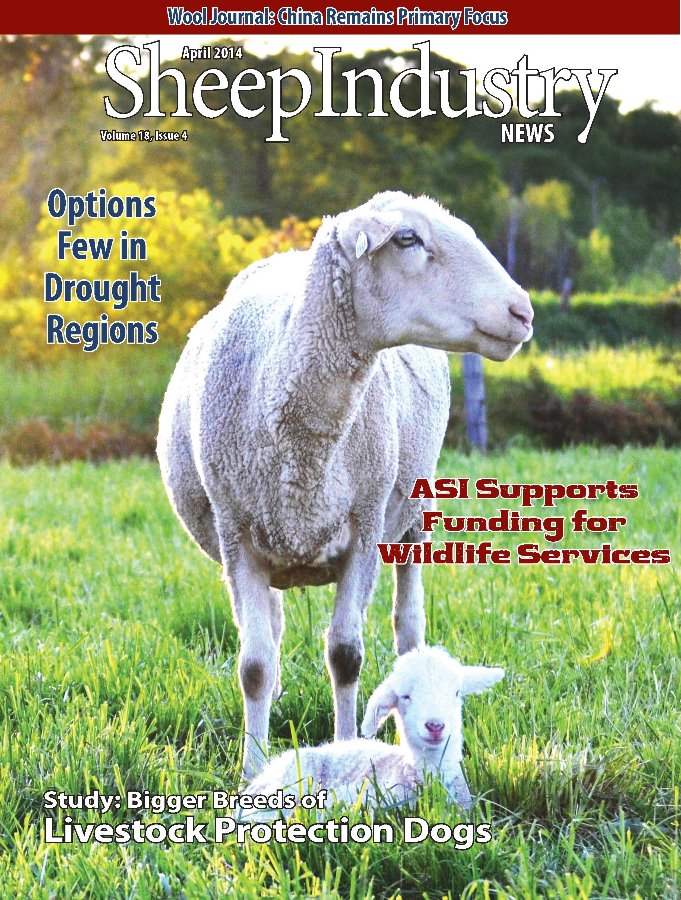
- April 2014
- President’s Notes
- Market Report
- ASI Takes Lead in Supporting Funding for Wildlife Services
- Larger LPD Breeds Being Considered
- Ranchers and Producers Affected by Drought Looking for Options
- States Release Wolf Reports, as Required by Feds
- Helping the Outdoor Industry ‘Rethink the Way it Sees Wool’
- Sheep Producer and Artist
- From Sheep Farm to Farm Bill
- Black Hills Stock Show Sheep Shearing Contest
To View the April 2014 Digital Issue — Click Here
A Brief History Lesson: Sheep Had a Surprising Start in U.S.
By Clint Krebs
ASI President
I mentioned last month, in light of our 150th anniversary, I plan to write about the history of our sheep industry between now and the convention in January. Initially, I intended to only write about events which happened in the last 150 years, but as I began researching some of the history, I discovered many stories which I feel need to be shared. What I’m about to share with you I learned from reading Sheep and Man by M. L. Ryder.
I was surprised to find out the first sheep recorded in what is now the United States were actually in Florida. The Spanish Colony of St. Augustine had 6,000 sheep and lambs, 200 cattle, 400 pigs, and 200 horses in 1565. Christopher Columbus, who was a weaver, brought Merinos, Churros – and later brought “hair sheep” from West Africa – to Haiti and Cuba in 1493. These sheep must have flourished to enable the first lamb imports to be this large.
By 1650, sheep had been distributed to eight towns and 72 different missions throughout the southeast. They also had two breeding centers where breeding stock was disbursed to the Native Americans. The second wave of sheep did come from Mexico. After Cortez conquered Mexico in 1521, he introduced Merinos and cattle. An expedition led by Coronado to explore the Colorado River in 1541 included 5,000 sheep. The sheep were a walking food source for those on the expedition. Coronado left two missionaries behind with sheep in what is now New Mexico. The missionaries were soon killed, but the Native Americans kept the sheep.
In 1598, several thousand wool and mutton sheep were moved north to the Rio Grande area to establish settlements, and in 1609 Santé Fe was founded with all Spanish origin sheep.
I found it interesting the native sheep (big horns) in North America and South America were never domesticated like the sheep were in Europe and Asia.
They tried to colonize Texas with people and sheep in the seventeenth century, but hostilities limited success until the eighteenth century, when mission stations were established. In 1745, four missions had over 9,000 sheep in Texas.
The third wave of sheep reached California in 1697, being trailed out of New Mexico and Arizona, and an overland trail was established between Santé Fe and Los Angeles, where thousands of sheep were trailed.
In San Jose, every settler was required to keep three sheep for every other animal, and in San Francisco only Merinos were permitted.
That’s the history lesson for now. Next month, I will write about the sheep coming to the east coast.
Shopping locally the easy way
I have mentioned before that I live in a very rural part of Eastern Oregon. We don’t have any fast food restaurant chains or even any large chain stores. We don’t have any stop lights.
In addition, we have the Columbia River with barge transportation, so I guess you could call our county a “pass-through county.”
Three years ago, Amazon decided to build a billion-dollar Web Server Farm in our small county, so now all of the emails, online orders and everything else Amazon touches, “pass-through” our county. The good thing about having the server farm here is I always try to shop local, just like a lot of our lamb customers. Now when I need to buy something like a new television that no one sells in my county, I can buy one on Amazon and I will still be shopping locally.”

